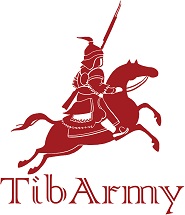|
|
|
Call for papersThe Ganden Phodrang Army and Buddhism International Symposium , 11-12 July 2017, Paris
A number of publications have addressed the question of the coexistence of Buddhism and violence, ultimately concluding that there is no paradox between the two.[1] In various cultural and historical contexts in Asia, the presence of Buddhism as the state religion has often involved the recourse to violence and the maintenance of an army as a necessity of government. Likewise, the policies of Buddhist rulers have repeatedly invoked religious reasons to justify military activities aimed at defending the Dharma.[2] The Tibetan government of the Dalai Lamas, the Ganden Phodrang (1642–1959) also maintained an army and was frequently implicated in military activities. This army has so far been little studied and is consequently poorly understood. It is now the object of research of the ERC-funded project “TibArmy” (“The Tibetan Army of the Dalai Lamas, 1642–1959”). This symposium is the first international gathering dedicated to the history of the Tibetan Army, and is devoted to the analysis of its existence within a regime predicated on Buddhist ideals. It aims at gathering information on the rapport between the Tibetan Army and the Buddhist religion prevalent in Tibet, whether in the form of close collaboration and support, mere reciprocal acknowledgement, or mutual interference. Moreover, it seeks to explore how Tibetan Buddhism provided a relevant framework for the development of military activities in Tibet and how the military and Buddhist spheres related to each other in discourse and practice from the 17th to the mid-20th century. We invite research contributions based on primary sources illustrating the role of the Tibetan Army vis-à-vis different aspects of the Buddhist religion during the historical period of the Ganden Phodrang. Possible themes include, but are not limited to: Tibetan monk-soldiers; commentaries, positive or negative, by Buddhist writers on the employment, or even the existence, of the Army; evidence of the justification of its use according to Buddhist tenets; rituals and invocations of wrathful deities in support of the Army’s intervention and success; and data on possible competition between the Army and monastic institutions. The symposium especially encourages contributions on periods prior to the 20th century. Research on how Bon religious masters commented on and reacted to the institution of the Tibetan Army is also welcome. Please note that other topics linked to the Tibetan army will be addressed in forthcoming conferences (see our website https://tibarmy.hypotheses.org/). Applicants are invited to submit an abstract of around 300 words on this website by 30 March 2017 for review by the organising committee.
[1] P. Demiéville 1957, “Le bouddhisme et la guerre: Post-scriptum à l’Histoire des moines guerriers du Japon de G. Renondeau,” in Mélanges publiés par l’Institut des Hautes Etudes Chinoises, Paris, Presses Universitaires de France, 347-385; M. Zimmermann (ed.), 2006, Buddhism and Violence, Lumbini International Research Institute, Lumbini; B. Faure, 2008, Bouddhisme et violence, Cavalier bleu, Paris; J.R. Hinnells and R. King (ed.), 2007, Religion and Violence in South Asia: Theory and Practice, Routledge, London; L. Schmithausen 2006, M.K. Jerryson and M. Juergensmeyer (ed.), 2010, Buddhist Warfare, Oxford, Oxford University Press; S.J. Tambiah, 1992, Buddhism betrayed?: Religion, Politics and Violence in Sri Lanka, University of Chicago press, Chicago; J.P. Dalton, 2011, The Taming of the Demons: Violence and Liberation in Tibetan Buddhism, Yale University Press, New Haven. [2] See for instance M. T. Bartholomeusz, 2002, In Defence of Dharma: Just-war Ideology in Buddhist Sri Lanka, London, Routledge. |


